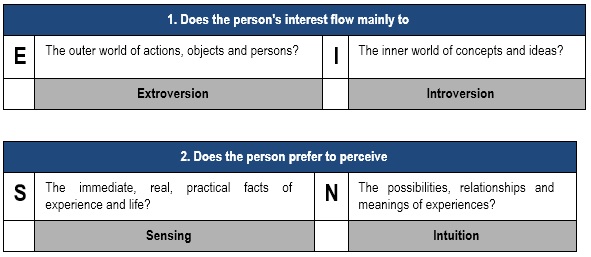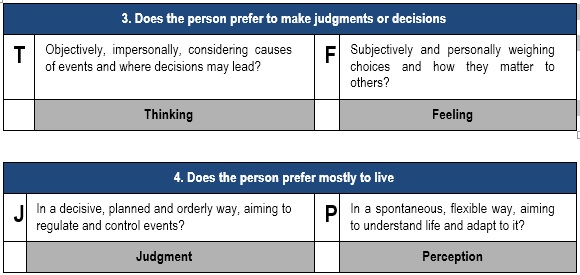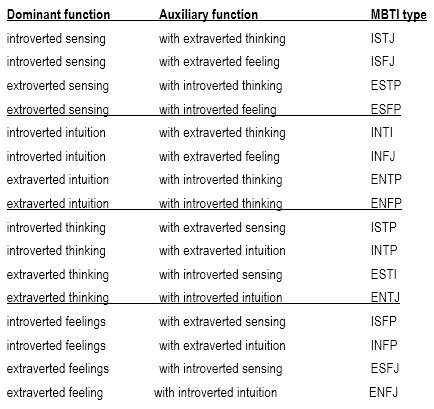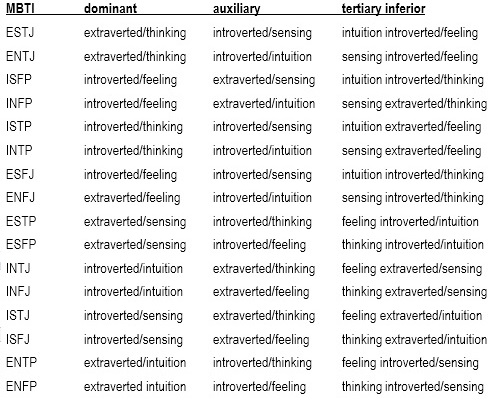Change Implementation Techniques for Laying a Foundation for New Ways
Technique 1.11 Psychometric Testing
Myers‐Briggs Type Indicator ‐ MBTI
Introduction
An example of Psychometric Testing ‐ Myers‐Briggs Type Indicator (MBTI)
. MBTI, based on psychological types, is a theory of personality developed by Carl Jung and refined by Myers and Briggs. It involves differences in behaviour that result from people's tendencies and preferences to use their minds in different ways. As people act on these tendencies, they develop patterns of behaviour.
. It is estimated that over 2.5 million take this test every year (Robert Spillane, 2012). It is used by 89 of the Fortune 100 firms.
. MBTI is about people's preferences and behaviours, ie what they pay attention to, what they care about and how they decide things. For example, some people are quick to notice other people's feelings; others like to explain things and sometimes don't notice people's feelings. These preferences and behaviours, or mental habits, are ingrained in a person and very hard to change.
. Furthermore, the better you understand how your group processes information and makes decisions, the better you can build new strengths in an effort to identify the levers to obtain better performance. This can be done by individual performance testing and then describing the group as a whole
. MBTI is useful in the following situations
‐ self‐understanding and development
‐ career development and exploration
‐ organisational development
‐ teambuilding
‐ management and leadership training
‐ problem solving
‐ relationship counselling
‐ education and curriculum development
‐ academic counselling
‐ multicultural training
. MBTI has been most useful in helping individuals understand their and their colleagues' differences in work style. On the other hand, applying the test to a group of people involves different dynamics. Nevertheless, the conceptual framework underlying MBTI can be a valuable starting point for managing change. The broad‐brush picture of your unit's strengths and weaknesses can provide the framework in the search for the "perfect" unit personality. For example, instead of focusing on how to make better use of your group members' individual preferences, you focus on structural group interactions to breach the chasms in the group's sometimes convergent ways of perceiving and processing information. This can help an organisation set a vision for a well rounded, multi‐skilled organisation to handle a competitive and unpredictable environment
"...the task is not to change an organisation into its opposite ‐ something that would be impossible to do anyway......Rather, the task is to develop the underdeveloped capacity of the organisation so that it can choose between what it does easily and naturally, and what it has learned to do with some difficulty..."
William Bridges as quoted by Kathleen Jordan, 2003
MBTI
MBTI maps an individual's personality preferences along these dimensions of the 4 dichotomies or opposites/poles
‐ Orientation of energy, ie
i) extraversion (energy is produced through interaction with the outer world of people and objects with focus on breadth and variety of experiences),
or
ii) introversion (energy is produced through inner experiences with ideas that focus on depth and intensity of private reflections)
‐ Relating to the outside world, ie
i) judging (approach to the outer world is to come to conclusions and make judgments with focus on closure, predictability, planning, organisation and control),
or
ii) perceiving (approach to the outer world is to gather information and perceive with focus on adaptability, flexibility, spontaneity and openness to new information)
Then judging and perceiving are divided into 2 poles each
i) decision‐making or coming to conclusions, ie judging
‐ thinking (conclusions based on logical analysis, focus on impartiality and objectivity),
or
‐ feeling (conclusions based on personal values and focus is on empathy and harmony)
ii) gathering information, ie perceiving
‐ sensing (information is gathered through 5 senses with focus on concrete facts, details and past experiences),
or
‐ intuitive (information is acquired as patterns or global wholes with focus on inter‐relationships, meanings and possibilities in the future)
Another way of considering this is to observe
. Where they prefer to focus their attention and the energy (extroversion or introversion)
. How they orientate themselves in the external world ‐ with a judging process or a perceiving process (judging or perceiving)
. The way they prefer to take in information (sensing or intuition)
. The way they prefer to make decisions (thinking or feeling)
Remember: everyone has a natural preference for 1 of the 2 opposites on each of the 4 MBTI dichotomies. You can use both poles at different times, but not both at once and not with equal confidence. When we use our preferred methods, we are generally at our best and feel most competent, natural and energetic.
Furthermore,
‐ extrovert does not mean talkative or loud
‐ introvert does not mean shy or inhibited
‐ feeling does not mean emotional
‐ judging does not mean judgmental
‐ perceiving does not mean perceptive
NB It is interesting that note that
"...Various psychological studies under controlled conditions have shown that introverts produced much more saliva than extroverts......The introverts salivate more because they are more sensitive to arousal..."
Robert Winston, 2003
while an extrovert has significantly lower levels of cortical arousement, ie it will take much more to arouse him/her than an introvert. Furthermore,
"...extroverts certainly show a tendency to think about the rewards rather than the possible meaning or consequences of their actions..."
Robert Winston, 2003
. On the other hand, extroverts are more likely to be lucky people, ie
"...there are three ways in which lucky people's extroversion significantly increases the likelihood of their having a lucky chance encounter......a large number of people, being a social magnet and keeping in contact with people..."
Richard Wiseman as quoted by Michael Shermer, 2006
Furthermore, lucky people smile twice as often and engage more eye contact than unlucky people do, which leads to more social encounters and generates more opportunities
. There is no right or wrong way to view these preferences. Each identifies normal and valuable human behaviours. Remember: each psychological type is
"...an underlying personality pattern resulting from dynamic interaction of our 4 preferences, environmental influences, and our own choices. People tend to develop behaviours, skills and attitudes associated with their type, and those types different from yours will likely be opposite to you in many ways. Each type represents a valuable and reasonable way to be. Each has its own potential strengths, as well as likely blind spots..."
Isabel Briggs Myer, 1998
. Some individuals tend to focus their energy and be energised more by the external world of people, experience and all activities, while others are more energised by the internal world of ideas, memories and emotions. The former is extroversion (acting in the outer world) and the latter is introversion (reflecting on the inner world).
. People's preferred mental process is called their dominant function, ie the natural preference for one of these functions over others leads individuals to direct energy toward it and to develop habits of behaviour and personality patterns characteristic of that function. In the hierarchy of preferences, the dominant function is the first and most used mental process. The auxiliary function is the second preference; the tertiary function is third; and the inferior function is fourth and the least preferred.
"...a person's dominant function is typically used in the direction of the preferred attitude ‐ either extraversion or introversion. A person's auxillary function is usually used in the direction of the opposite, not preferred attitude ‐ if the dominant is extraversion, the auxillary is introverted, and vice versa. A person's tertiary function maybe used in either direction, depending on circumstances or individual habits. A person's inferior function is typically used in the opposite direction to that of the dominant ‐ if the dominant is introverted, the inferior is extraverted, and vice versa......the inferior function is largely unconscious ‐ we don't direct and control it. Its unconscious energy interrupts and takes over our personality when a conscious energy diminishes sufficiently. We often remain unaware of the change in ourselves until the experience is over..."
Naomi L Quenk, 2000
. The tertiary functions revolve around intuition, sensing, feeling and thinking, ie exclude introversion/extroversion and are the opposite of the auxiliary preference. The inferior function is described as the "other in us".
"...it is the version of ourselves and puzzles us when it emerges from time to time as unusual, out‐of‐character thoughts, feelings and behaviours. And we are just as surprised when we see others acting in ways that are strange and atypical of them. When people appear very different from usual, such terms as irrational, out of control, unstable, crazy and abnormal spring to mind......more often, however, we are uncomfortable, distressed, and at a loss to explain what the episode might mean..."
Naomi L Quenk, 2000
The inferior function can often be triggered by fatigue, illness, stress (physical and/or psychological), substance abuse (alcohol, other drugs, etc), life transitions (mid‐life crisis, drastic career changes, romantic affairs, etc), etc
. The psychological energy available to the 4 mental functions (sensing, intuition, thinking and feeling) is directed or pushed by the extraverted or introverted attitudes. An introverted attitude pushes sensing, intuition, thinking and feeling outward toward people, things and actions, while an introverted attitude pushes mental functions (sensing, intuition, thinking and feeling) towards inner ideas, experiences and reflection.
. Combining a person's preferences in each of these 4 dimensions results in what is known as a psychological type, eg an ESTJ is an extroverted, sensing, thinking and judging type of personality
. MBTI describes 16 different people types by 16 combinations of letters, namely ISTJ, ISFJ, INFJ, INTJ, ISTP, ISFP, INFP, INTP, ESTP, ESFP, ENFP, ENTP, ESTJ, ESFJ, ENFJ and ENTJ. Each type is different from the others in important ways and the concept suggests that people's behaviours are not random. There are "psychological types" in the way people prefer to perceive and make judgments. In fact, there are
"...four mental processes or functions ‐ two perception processes (sensing and intuition) and two judgment processes (thinking and feeling)..."
C G Jung as quoted by Gordon Lawrence, 1996
What comes into consciousness, moment by moment, comes either through the senses or through intuition. To maintain consciousness, perceptions must be used ‐ sorting, weighing, analysing and evaluating ‐ processes which involve thinking and feeling
. It helps to explain why certain approaches to instruction or supervision are successful with some people and not with others. It is known that some people prefer sensing perception over intuitive perception; an active (extroverted) approach to problem solving over a reflective (introverted) approach. This type of information can have a significant effect on individual and organizational efficacy
MBTI concentrates on the dominant and auxiliary functions.
. Remember: the 16 MBTI types are not static. Instead they describe dynamic energy systems with interacting processes based on extraversion/introversion, sensing/intuition, thinking/feeling, and judging/preceding. Furthermore, it is the combination of the 4 preferences that provides the best picture of each type
There are 4 preferences which are scored to arrive at a person's type, ie
Another way of explaining this involves
1 The E‐I dichotomy
Where do you prefer to direct your attention?
From where do you get your energy?
‐ extroversion (people who prefer extraversion like to focus on the outer world of people and activity. They direct their energy and attention outward and receive energy from interacting with people and from taking action). Characteristics associated with people who prefer extroversion:
i) attuned to external environment
ii) prefer to communicate by talking
iii) work out ideas by talking them through
iv) learn best through discussion
v) have broad interests
vi) sociable and expressive
vii) readily take initiative at work and in relationships
‐ introversion (people who prefer introversion like to focus on their own in a world of ideas and experiences. They direct their energy and attention inwards and receive energy from reflecting on their thoughts, memories and feelings.) Characteristics associated with people who prefer introversion:
i) drawn to their inner world
ii) prefer to communicate in writing
iii) work out ideas by reflecting on them
iv) learn best by reflection, a mental practice
v) focus in depth on their interests
vi) private and contained
vii) take initiative when the situation or issue is very important to them
2 The S ‐ N dichotomy
How do you prefer to take in information?
‐ sensing (people who prefer sensing like to take in information that is real and tangible ‐ what is actually happening. They are absorbed about the specifics of what is going on around them and are especially focused on the practical realities). Characteristics associated with people who prefer sensing:
i) oriented to present realities
ii) factual and concrete
iii) focus on what is real and actual
iv) observe and remember specifics
v) build carefully and thoroughly toward conclusions
vi) understand ideas and theories through practical applications
vii) trust experience
‐ intuition (people who prefer intuition like to take in information by seeing the big picture, focusing on the relationships and connections between facts. They want to grasp patterns and are especially attuned to seeing new possibilities). Characteristics associated with people who prefer intuition:
i) oriented to future possibilities
ii) imaginative and verbally creative
iii) focus on the patterns and meanings in data
iv) remember specifics when related to a pattern
v) move quickly to conclusions
vi) want to clarify ideas and theories before putting them into practice
vii) trust inspiration
3 The T ‐ F dichotomy
How do you make decisions?
‐ thinking (people who prefer to use thinking in decision‐making like to look at the logical consequences of a choice or action. They want to mentally remove themselves from the situation to examine the pros and cons objectively. They are energised by critiquing and analysing to identify what's wrong, so that they can solve the problem. Their goal is to find a standard or principle that will apply in all similar situations). Characteristics associated with people who prefer thinking:
i) analytical
ii) use cause‐and‐effect reasoning
iii) solve problems with logic
iv) strive for an objective standard of truth
v) reasonable
vi) can be tough‐minded
vii) fair ‐ want everyone treated equally
‐ feeling (people who prefer to use feeling in decision‐making like to consider what is important to them and to others involved. They mentally place themselves into the situation to identify with everyone so they can make decisions based on their values about honouring people. They are energised by appreciating and supporting others and look for qualities to praise. Their goal is to create harmony and to treat each person as an unique individual). Characteristics associated with people who prefer feelings:
i) empathetic
ii) guided by personal values
iii) assess impacts of decisions on people
iv) strive for harmony and positive interactions
v) compassionate
vi) may appear tender‐hearted
vii) fair ‐ want everyone treated as an individual
4 The J ‐ P dichotomy
How do you deal with the outer world?
‐ judging (people who prefer to use their judging process in the outer world like to live in a planned, orderly way, as they seek to regulate and manage their lives. They want to make decisions, come to closure and move on. Their lives tend to be structured and organised, and they like to have things settled. Sticking to a plan and schedule is very important to them, and they are energised by getting things done). Characteristics associated with people who prefer judging:
i) scheduled
ii) organise their lives
iii) systematic
iv) methodical
v) make short‐term and long‐term plans
vi) like to have things decided
vii) try to avoid last‐minute stresses
‐ perceiving (people who prefer to use their perceiving process in the outer world like to live in a flexible, spontaneous way, seeking to experience and understand life, rather than control it. Detailed plans and final decisions feel confining to them; they prefer to stay open to new information and last‐minute options. They are energised by their resourcefulness in adapting to the demand of the moment). Characteristics associated with people who prefer perceiving:
i) spontaneous
ii) flexible
iii) casual
iv) open‐ended
v) adapt, change course
vi) like things loose and open to change
vii) feel energised by last‐minute pressures
The dominant and auxiliary functions can be combined into 16 MBTI types:
Another way of briefly describing of 16 types
‐ ENTJ, ie intuitive, innovative organisers; analytical, systematic, confident; push is to get action on new ideas and challenges
‐ ESTJ, ie fact‐minded, practical organisers; assertive, analytical, systematic; push is to get things done and work smoothly and efficiently
‐ INTP, ie inquisitive analyser; reflective, independent, curious, more interested in organising ideas than situations or people
‐ ISTP, ie practical analyser; values exactness; more interested in organising data than situations or people; reflective, a cool and curious observer of life
‐ ESTP, ie realistic adapter in the world of material things; good natured, tolerant, easy going; oriented to practical, first‐hand experience, highly observant of detail
‐ ESFP, ie realistic adapter in human relationships; friendly and easy with people, highly observant of their feelings and needs; oriented to practical, first‐hand experience
‐ ISTJ, ie analytical manager of facts and details; dependable, decisive, painstaking and systematic; concerned with systems and organisation; stable and conservative
‐ ISFJ, ie sympathetic manager of facts and details, concerned with people's welfare; dependable, painstaking and systematic; stable and conservative
‐ ISFP, ie observant, loyal helper; reflective, realistic, empathetic, patient with details, gentle and retiring; shuns disagreements; enjoys the moment
‐ INFP, ie imaginative, independent helper; reflective, inquisitive, empathetic, loyal to ideals; more interested in possibilities than practicalities
‐ ESFJ, ie practical harmoniser and worker‐with‐people; sociable, orderly, opinionated; conscientious, realistic and well tuned to the here and now
‐ ENFJ, ie imaginative harmoniser and worker‐with‐people; sociable, expressive, orderly, opinionated, conscientious, curious about new ideas and possibilities
‐ INFJ, ie people‐oriented innovator of ideas; serious, quietly forceful and persevering; concerned with the common good, with helping others develop
‐ INTJ, ie logical, critical, decisive innovator of ideas; serious, intense, highly independent, concerned with organisation; determined and often stubborn
‐ ENFP, ie warmly enthusiastic planner of change; imaginative, individualistic; inspiration with impulsive energy; seeks to understand and inspire others
‐ ENTP, ie inventive, analytical planner of change; enthusiastic and independent; inspiration with impulsive energy; seeks to understand and inspire others
Summary of Myers-Briggs Type Indicator

(source: https://infograph.venngage.com)
An example
. Graham Turner (Skroo) founder of Flight Centre is an INTP, ie scores highest in categories of introversion, intuition, thinking and perception. INTP people value ideas, principles and abstract thinking, and seek to understand the world, not control it. He has the ability to break down the most complex issues into simple terms; he is self‐sufficient and fails to understand other people's needs for approval or praise
Inferior function (the Grip)
. The Grip is least developed part, ie infantile, of our personality. Ii involves an out‐of‐character behaviour that occurs from time to time, particularly in response to the fatigue and stress that can occur in a change process. It explains that seemingly aberrant, abnormal manifestations of ourselves are, in fact, predictable, adaptable and necessary expressions of our usual personalities
. Some research has shown that we use up to 100 times more oxygen when engaged in activities that are against our preferences. In other words, it is very exhausting to do things that are not natural for us.
. A complete map of dominant, auxiliary, tertiary and inferior functions
More on Myers-Briggs Personality Types

(source: https://infograph.venngage.com)
. The most useful way to use personality tests is to help identify individual members' basic psychological orientations. This can facilitate a gap analysis of the strengths and weaknesses of the team. However, do not use it to
‐ help understand the particularities of a group's interactions
‐ determine a psychological type of your group as a whole.
‐ understand how your group processes information and makes decisions
. For groups/organisations, the MBTI's 4 dimensions can be classified in response to a question about preferences, motivation, information processing and decision‐making
‐ what's the source of your organisation's energy?
Extroverted organisations look outwards, creating strategies that are driven by market forces for customer needs. On the other hand, introverted organisations typically look inwards, organising strategy around internal core competencies or leaders' values
‐ how does your organisation absorb information?
If it is sensing, it is attuned to the concrete details and tried‐and‐true realities of business. On the other hand, if it is intuitive, it is more interested in the big picture, possibilities and a sense of what lies beneath the obvious
‐ how does your organisation make decisions?
In a thinking mode, information is processed by using objective principles and logical analysis. In contrast, when using a feeling orientation, decisions are based primarily on the personal values of the people involved
‐ how does your organisation deal with the external environment?
Judging organisations prefer to reach closure and to make firm decisions; perceiving organisations give greater weight to discussion, flexibility and the ability to gather additional information. For example, the usual conflict between line functions and support staff members in a big organisation is that the former have a strong judging orientation, while the latter are often perceiving. The support staff tends to be more reflective and emphasize situational complexity; on the other hand, the operational groups emphasize action and would happily settle for a quick‐and‐dirty solution to the organisation's problems
Applying the theory to build a well‐rounded unit
. There is no one best preference or set of preferences. Rather, each tendency in each of the MBTI's 4 dimensions has intrinsic strengths. To prosper in the current climate, organisations are required to call upon all these strengths at different times. In particular, work teams are often created so that they are as diverse as possible in their approach to analysing data and problem solving. The concept of a well functioning individual, ie someone who has learnt many ways of processing information and making decisions, applies equally well to groups. In fact, the more adept an organisation is in bringing the strengths of all preferences to bear on the competitive realities, the better its performance will be. On the other hand, it takes longer to meld a heterogeneous group of people into a cohesive unit. Varying perspectives and approaches lead to more frequent misunderstandings and conflict. Even once cohesion is achieved, the group may take longer to reach a decision than a more homogeneous team would.
. The 4 diagnostic questions listed earlier are not to be used to pigeonhole units but to guide a process of dialectical integration. By understanding individual members' psychological types, group leaders can manage members' polar opposite preferences so that they complement or round out one another. This can result in an improvement in the skills associated with a particular group's non‐dominant preferences. For example, optimum outcomes maybe achieved when a sensing group learns how to take advantage of the skills of an intuitive member.
. Thus an extroverted group can develop the capacity to learn more from inside the organisation and allow more time for reflection before implementing change. For example, the R&D department of a high‐tech firm that focuses on what it is most skilled at; without matching those skills to what the market needs. As a result, the organisation continues to improve the performance and functionality of its products and/or service without realising that its customer might not be interested in the additional functionality. A possible remedy: the introduction of an empathic design process that allows the R&D department to have customers actually perceive the use of the product and/or services
. On the other hand, an introverted group may need to pay more attention to markets, ask for more input from outside stakeholders, and keep all stakeholders in the loop. For example, a small start‐up, hyper‐responsive to market swings and which moves way from its signature strengths too quickly, might try to map its core capabilities in detail, so that it is better able to choose market opportunities that are linked with its core capabilities
. A sensing unit needs to give more credence to the big picture, holistic thinking and nurture innovative ideas. For example, a sensing unit might need to hold regular brainstorming sessions and intentionally scan the competitive environment to find more innovative ideas to incorporate into the organisation ‐ will help this group handle the rapidly changing environment.
. In contrast, an intuitive group would need to learn to pay more attention to facts, communicate with greater specificity, and to give more serious consideration to the practical implications of creative ideas. For example, a highly imaginative but loosely managed organisation that seems to spin the wheels might gain more traction by instituting formal procedures for monitoring costs and deadlines, and for weighing potential projects against available resources
. A thinking team can learn to notice what inspires people at high levels, to factor people's values into their decision‐making criteria, and in general pay more attention to the human side of the organisation
. Feeling teams can improve the ability to clarify their principles so that compassion does not destroy fairness and every individual situation does not send the decision‐making process back to "go"
. Judging organisations can learn to avoid jumping to conclusions or acting prematurely
. Perceiving organisations can create more structure so that they don't have to reinvent the wheel each time they perceive of products and/or service, and/or face a new challenge
In the final analysis, it's the capacity to maintain a tension between apparently opposite characteristics that represents organisational health
Modeling the integration
Leadership plays a crucial role in helping a team strengthen its underdeveloped preferences. This involves inclusion and integration of all perspectives, and showing respect for different views
Furthermore, you need to understand the specific forces that cause an organisation to act, ie
‐ What is driving the difference between what we need to be doing and what we are doing now?
‐ What are the unstated beliefs that drive our behaviour?
More on Myers-Briggs types

(source: https://infograph.venngage.com)
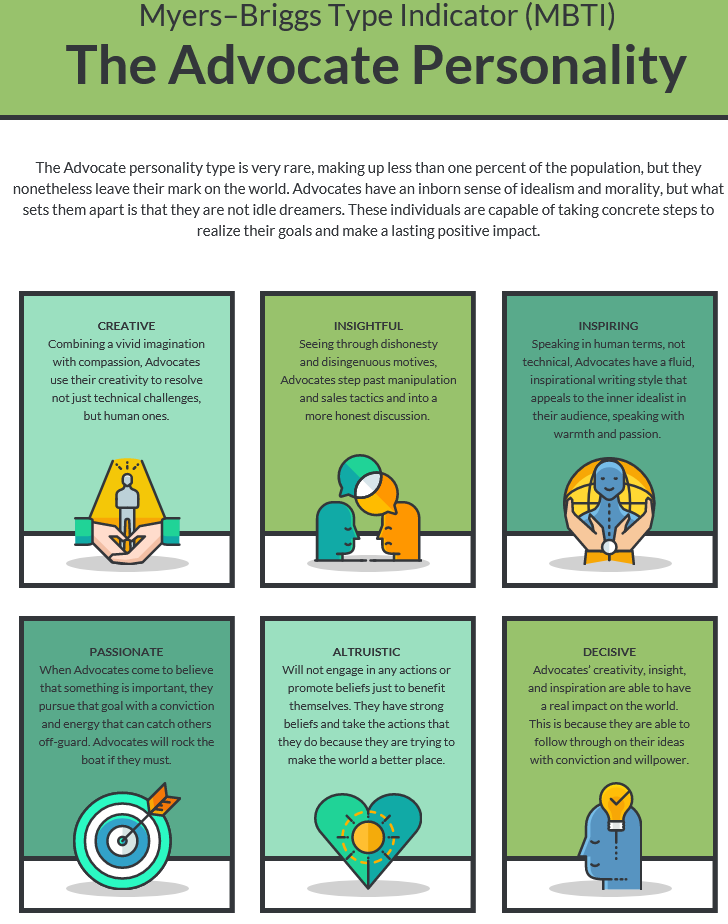
(source: https://infograph.venngage.com)
Limitations of MBTI
. If these psychological tests are used in power games within the organisations, this is mis‐use. The psychological tests are intended to allow individuals to understand and master themselves. They should never be used to manipulate and coerce others. This has been referred to psychological tyranny which allows managers to control colleagues more effectively. Managers who get involved in psychological power games destroy the integrity of the relationship with their colleagues and, with it, respect for the role.
Create an illusion of understanding
"...Taxonomies of personalities give you an illusion of understanding......they suggest some of the differences across organisations but end up being useless because they are so general..."
Edgar H Schein as quoted by Kathleen Jordon, 2003
Furthermore,
"...we categorise and ascribe personalities and attributes to people on a superficial understanding of them and fail to understand the complexity of the human brain..."
Robert Winston, 2003
. Some limitations revolve around fakeability, gender differences, linearity bias and uncertainty, ie
‐ fakeability (it is relatively easy to fake the results so that you can become any personality you want to)
‐ gender differences (most personality tests are race‐neutral, but not for male‐female differences)
‐ linearity bias (usually the higher the score, the better it is ‐ but this is not necessarily so)
‐ uncertainty (it is not clear if the dimensions used in personality tests are independent of each other)
. Even categories such as entrepreneurial culture and commodity culture are very broad labels used to differentiate organisations. On other hand, they do not help practising managers to understand a particular organisation. The real question is how well does the construct of organisational personality help an organisation promote strategic change?
It has been suggested that a static personality label probably creates more obstacles than opportunities as a lever of change. For example, personality labels imply unchangeable characteristics, ie organisational determinism that can encourage status quo thinking and can provide an excuse for dysfunctional behaviour.
. Need to be aware of the Forer or Bartram effect ‐ otherwise known as a sucker‐born‐every‐minute effect. This suggests that people will agree with something if it is flattering to themselves. An example is considering the daily horoscope in the local newspaper: it sounds uncannily like you because it puts things in a way that flatters readers and we are very receptive to flattery.
. Claims that the test is too invasive.
. The ability to predict over a different range of environments and to predict work performance from personality test is challenged, ie
"...personality tests are discriminatory, unreliable, invalid and cannot predict work performance..."
Robert Spillane, 2012
(sources: Gordon Lawrence, 1996; Kathleen Jordan, 2003; Isabel Briggs Myers et al, 1998; Lawry Scandar, 2003 & 2004; Naomi L Quenk, 2000; BDO Kendalls, 2005; Harry Onsman, 2004e; Robert Winston, 2003; Michael Shermer, 2006; Rachel Trumen, 2003; Herrman International, 2004; Mike Hanley, 2007a; Robert Spillane, 2008; Fiona Smith, 2009s; Robert Spillane, 2012)

